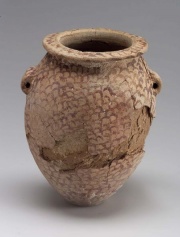Difference between revisions of "Spall"
Jump to navigation
Jump to search
m (Text replace - "== Authority ==" to "== Sources Checked for Data in Record ==") |
m (Text replace - "\[http:\/\/cameo\.mfa\.org\/materials\/fullrecord\.asp\?name=([^\s]+)\s(.*)\]" to "$2") |
||
| Line 4: | Line 4: | ||
A irregular sized chip or fragment from a ceramic, masonry, stone, or ore surface. Spalling, or breaking up, of the surfaces are often induced by freeze-thaw action, corrosion, or salt formation. | A irregular sized chip or fragment from a ceramic, masonry, stone, or ore surface. Spalling, or breaking up, of the surfaces are often induced by freeze-thaw action, corrosion, or salt formation. | ||
| − | See also [ | + | See also [[exfoliation|exfoliation]], and [[flaking|scaling]]. |
== Synonyms and Related Terms == | == Synonyms and Related Terms == | ||
Revision as of 11:20, 10 May 2016
Description
A irregular sized chip or fragment from a ceramic, masonry, stone, or ore surface. Spalling, or breaking up, of the surfaces are often induced by freeze-thaw action, corrosion, or salt formation.
See also Exfoliation, and scaling.
Synonyms and Related Terms
spalling; spaul
Additional Images
Sources Checked for Data in Record
- Random House, Webster's Encyclopedic Unabridged Dictionary of the English Language, Grammercy Book, New York, 1997
- The American Heritage Dictionary or Encarta, via Microsoft Bookshelf 98, Microsoft Corp., 1998
- Richard S. Lewis, Hawley's Condensed Chemical Dictionary, Van Nostrand Reinhold, New York, 10th ed., 1993
- Dictionary of Building Preservation, Ward Bucher, ed., John Wiley & Sons, Inc., New York City, 1996
